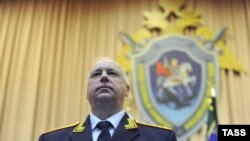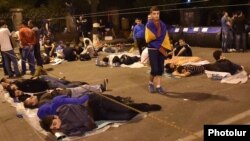The United States fomented recent street protests against an electricity price hike in Armenia to try to install a pro-Western government in Yerevan, a powerful Russian security official alleged in a newspaper interview published on Tuesday.
Aleksandr Bastrykin, the head of Russia’s Investigative Committee reputedly close to President Vladimir Putin, said the protests dubbed “Electric Yerevan” were “somewhat similar” to the “Euromaidan” movement in Ukraine that deposed the country’s pro-Russian President Viktor Yanukovych last year.
“Many observers noted suspicious features not characteristic of earlier protest actions in Armenia,” he told the government-controlled daily “Rossiiskaya Gazeta.” “For example, there were masked people in the crowd who openly called for violence against representatives of the state.
“It is those people who showed other protesters very effective methods of defense against water cannons. All police actions thwarting the protesters’ provocations were filmed by mobile phone cameras and that footage was probably shared with the masterminds of those events.”
“Besides, there were people with European Union flags in the crowd, who were apparently supposed to show the protesters the path to the ‘bright future’ that awaited Armenia in case of its integration with the European, rather than Eurasian, union,” Bastrykin went on. “All this testifies to the preplanned and provocative character of the actions that were aimed at creating grounds for escalating the slowly simmering conflict into a more active phase.”
Bastrykin noted in that regard that the U.S. Embassy in Armenia criticized the June 23 violent dispersal by riot police of mostlyyoung protests who blocked a central Yerevan avenue and called for a “full and transparent investigation” into “reports of excessive police use of force.”
“It looks like the [United] States was not quite satisfied with the fact that in the end the conflict situation did not reach the kind of revolutionary scale and destructive character that was seen in Ukraine,” he said.
Russian government officials as well as pro-Kremlin politicians and pundits were quick to express concern at the nonstop protests against a more than 17 percent rise in electricity prices announced by Armenian regulators earlier in June. Foreign Minister Sergey Lavrov spoke of similarities between “Electric Yerevan” and the popular uprising in Kiev which Moscow says was engineered by the West.
Young and non-partisan leaders of “Electric Yerevan” strongly denied having any domestic or foreign policy agendas throughout their two-week campaign, saying that they only want the Armenian authorities to reverse the price hike. The campaign died down after the authorities agreed to subsidize the energy tariffs in the country. Neither President Serzh Sarkisian nor other Armenian leaders alleged any Western involvement in the protests.
Russian Transport Minister Maxim Sokolov underlined Moscow’s fears of another “Euromaidan” when he visited Yerevan at the height of the nonstop protests in late June. Senior Armenian officials said after talks with Sokolov that Armenia’s Russian-owned power distribution network, blamed by many Armenians for the price rise, will go undergo a special international audit aimed at determining whether it is indeed mismanaged by its parent company, Inter RAO.
It was also announced during Sokolov’s trip that Russian law-enforcement authorities have agreed to let Armenian courts try a Russian soldier accused of murdering an Armenian family in Gyumri in January. In addition, the Russian government disbursed a $200 million low-interest loan which Armenia will spend on buying more Russian-made weapons for its armed forces.
Those developments were widely construed as a Russian effort to bolster Sarkisian and placate angry Armenians. Some commentators in Yerevan went as far as to claim that the Armenian president exploited the protests to clinch major concessions from the Russians.






